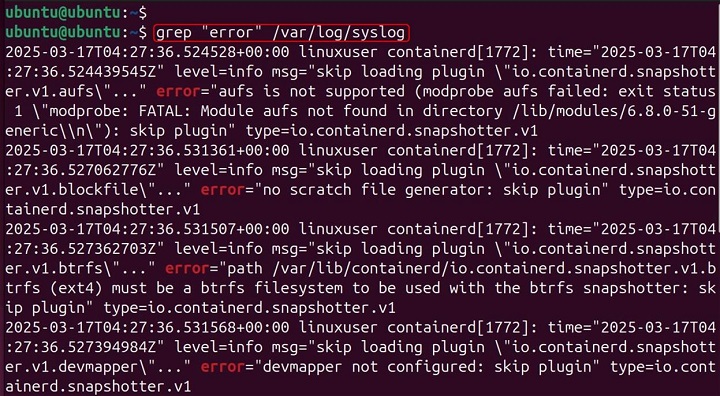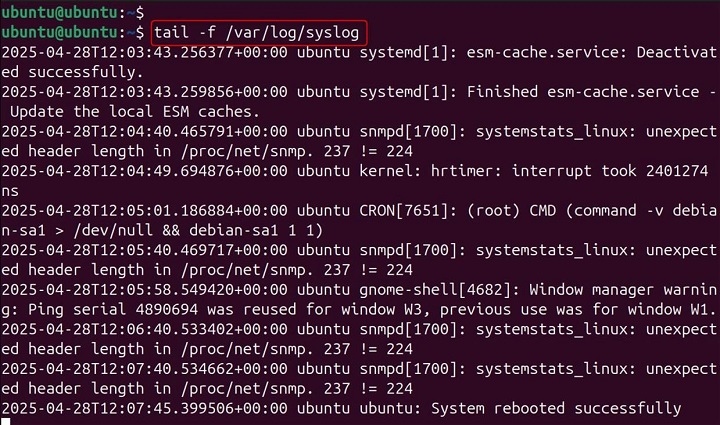
sysklogd Command in Linux
The sysklogd command in Linux is a system logging utility that provides support for both system logging and kernel message trapping. It consists of two main components: syslogd, which handles system logging, and klogd, which manages kernel logging. These utilities work together to collect and store log messages from various sources, including applications, system processes, and the kernel itself.
The logs generated by sysklogd are crucial for monitoring system activity, diagnosing issues, and maintaining security. By default, syslogd reads its configuration from /etc/syslog.conf, which defines how different types of log messages should be processed and stored.
Let's expand the explanation of the Linux sysklogd command with detailed theoretical concepts, practical examples, and advanced configurations.
Table of Contents
Here is a comprehensive guide to the options available with the sysklogd command −
- Understanding sysklogd Command
- Installing of sysklogd Command in Linux
- How to Use sysklogd Command in Linux?
- Syntax and Options of sysklogd Command
- Configuring sysklogd Command in Linux
- Examples of sysklogd Command in Linux
- Security Considerations of sysklogd Command
- Troubleshooting for sysklogd Command Issues
Understanding sysklogd Command
One of the key features of syslogd is its ability to support both local and remote logging. This means that log messages can be collected from multiple machines and stored centrally, making it easier to manage logs in a distributed environment. Remote logging is enabled using the -r option, allowing a system to receive log messages from other hosts.
However, this feature should be used with caution, as improper configuration can lead to security vulnerabilities, such as log spoofing or unauthorized access to log data. Additionally, syslogd can filter log messages based on priority levels, ensuring that critical messages are stored separately from less important ones.
What is sysklogd?
Logging is a critical aspect of system administration. It helps track system events, diagnose issues, monitor security, and analyze performance. The sysklogd package provides logging capabilities for both system processes and kernel messages.
sysklogd consists of two main components −
- syslogd Handles system logging.
- klogd Manages kernel logging.
These daemons work together to capture, store, and manage logs from various sources, including applications, system processes, and the Linux kernel.
Why is Logging Important?
- System Monitoring − Logs system events for troubleshooting.
- Security Auditing − Tracks unauthorized access attempts.
- Performance Analysis − Helps identify bottlenecks.
- Remote Logging − Supports logging across multiple machines.
Components of sysklogd
syslogd (System Logging Daemon)
The syslogd daemon collects log messages from various system processes and applications. It stores logs in files such as −
- /var/log/syslog
- /var/log/auth.log
- /var/log/kern.log
- /var/log/mail.log
klogd (Kernel Logging Daemon) − The klogd daemon captures kernel messages and logs them appropriately. It can operate independently or as a client of syslogd.
Installing of sysklogd Command in Linux
Most Linux distributions come with sysklogd pre-installed. However, if it is missing, install it using −
sudo apt update && sudo apt install sysklogd

For Red Hat-based systems −
sudo yum install sysklogd
How to Use sysklogd Command in Linux?
The klogd utility, which is part of sysklogd, is responsible for capturing kernel messages. These messages provide insights into the internal workings of the Linux kernel, including hardware interactions, driver operations, and system errors.
klogd can operate independently or as a client of syslogd, forwarding kernel messages to the system log. This flexibility allows administrators to configure logging based on their specific needs. Kernel logs are particularly useful for debugging hardware-related issues, analyzing system crashes, and monitoring performance metrics.
Syntax and Options of sysklogd Command
Basic Syntax −
syslogd [options] klogd [options]
Common syslogd Options
- -a socket Specifies additional sockets for logging.
- -d Enables debug mode.
- -f config-file Uses an alternative configuration file.
- -m interval Sets the interval for -- MARK -- timestamps.
- -p socket Specifies an alternative Unix domain socket.
- -r Enables remote logging.
Common klogd Options
- -c Logs messages to the console.
- -d Enables debug mode.
- -f Runs klogd in the foreground.
- -n Prevents daemonizing.
Configuring sysklogd Command in Linux
The main configuration file for syslogd is /etc/syslog.conf. This file defines where and how logs are stored.
Log all kernel messages to /var/log/kern.log
kern.* /var/log/kern.log

Log authentication messages to /var/log/auth.log
auth.* /var/log/auth.log

Log mail-related messages to /var/log/mail.log
mail.* /var/log/mail.log

Applying Configuration Changes
After modifying /etc/syslog.conf, restart syslogd −
sudo systemctl restart syslogd

Examples of sysklogd Command in Linux
Viewing System Logs
To view system logs, use −
cat /var/log/syslog

Or filter logs using grep −
grep "error" /var/log/syslog

Logging Kernel Messages
To check kernel logs −
dmesg less
Or use klogd −
sudo klogd -c
Sending Custom Log Messages
Use the logger command to send messages −
logger "System rebooted successfully"

Check the log −
tail -f /var/log/syslog

Enabling Remote Logging
To enable remote logging, modify /etc/syslog.conf −
*.* @remote-server-ip
Restart syslogd −
sudo systemctl restart syslogd

Security Considerations of sysklogd Command
Note the following security consideration −
- Restrict Remote Logging − Disable -r unless necessary.
- Protect Log Files − Set proper permissions:
chmod 600 /var/log/syslog

Monitor Logs Regularly − Use automated log analysis tools.
Troubleshooting for sysklogd Command Issues
Overall, sysklogd plays a vital role in maintaining system stability and security by providing comprehensive logging capabilities. Its ability to capture and store log messages from various sources makes it an essential tool for troubleshooting and monitoring system activity. Whether used for local logging or in a distributed setup, sysklogd helps administrators keep track of important events and respond to issues effectively. Understanding its configuration and features allows users to optimize their logging setup, ensuring that critical information is always available when needed. You can find more details about sysklogd here.
Issue 1 − Logs Not Updating
Check if syslogd is running −
sudo systemctl status syslogd

Restart if necessary −
sudo systemctl restart syslogd

Issue 2 − Kernel Logs Not Captured
Ensure klogd is running −
sudo systemctl status klogd

Restart −
sudo systemctl restart klogd

Issue 3 − Remote Logging Not Working
Verify firewall settings −
sudo ufw allow 514/udp

Ensure remote logging is enabled in /etc/syslog.conf.
Conclusion
The sysklogd command is a powerful logging utility that helps administrators monitor system events, troubleshoot issues, and enhance security. By configuring syslogd and klogd effectively, you can ensure efficient log management. Configuration of sysklogd is done through the /etc/syslog.conf file, where administrators can define rules for handling different types of log messages.
Each rule consists of a selector and an action, specifying which messages should be logged and where they should be stored. For example, messages related to authentication failures can be directed to a separate log file for security auditing. Additionally, log rotation mechanisms can be implemented to prevent log files from growing too large, ensuring efficient log management. The ability to customize logging behavior makes sysklogd a versatile tool for system administration.